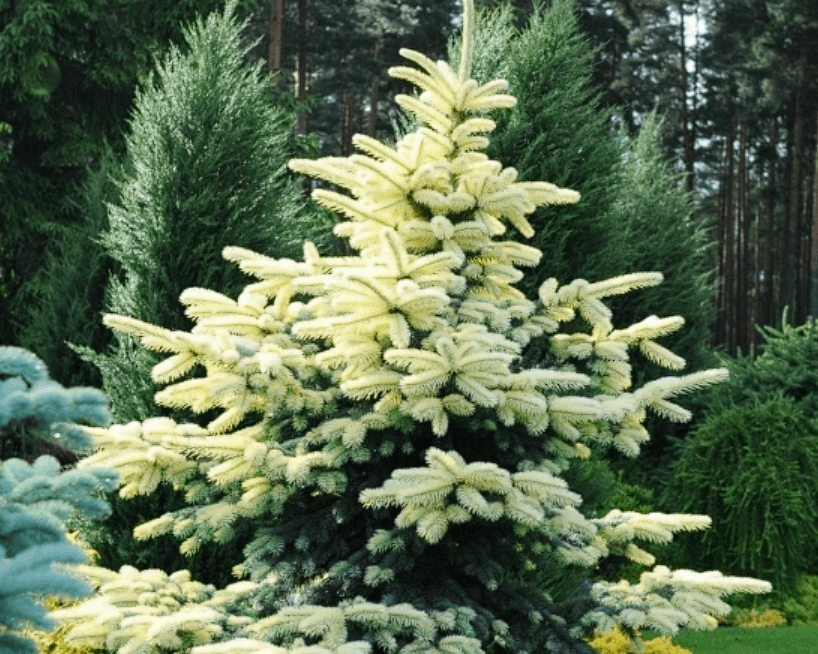Content
Spruce Maigold is a small ornamental tree. Used in landscape design for solitary and group plantings with other coniferous plants. It is especially popular due to the unusual combination of golden-yellow and green colors of the needles.
History of origin
North America is considered the homeland of the Maigold spruce. The first mentions of it occur at the beginning of the last century.
The coniferous tree was brought to Europe. Its appearance, unpretentiousness and frost resistance became the reason for its further spread.
Description of the Maigold prickly spruce
Maigold spruce is a coniferous tree with a wide-conical crown shape. Its peculiarity is that the winter needles do not have time to fall before the spring growth. This creates an unusual effect when a border of light yellow shade is formed on top of the dark green color.

The new needles of the Maigold spruce have a very bright golden hue, which makes it stand out from other members of the family
The width of the tree is no more than 3 m. The crown retains a lush and dense conical shape with timely pruning.The branches of the Maigold spruce are distributed unevenly, and small voids may form.
Height of Maigold spruce
Decorative spruce, when planted in flowerpots or other containers, reaches a height of 40 cm, in open ground - 2-4 m. Annual growth is 20-30 cm.
With a small growth force, the Maigold spruce grows up to 2.5 meters in ten years. Therefore, it is often used in landscape design.

The shoots of the Maigold spruce are short, always hard and strictly horizontal
Frost resistance
One of the reasons for the popularity of Maigold spruce is its frost resistance. The tree can withstand the harshest winters. It belongs to the third frost resistance zone and can withstand temperatures down to -40 °C.
Resistance to frost allows planting in urban areas.

The crown of the Maigold spruce does not fall off even in a cold winter and remains dark green
Advantages and disadvantages
The interesting shape of the crown and its spring color attract the attention of lovers of ornamental plants. At the same time, the Maigold spruce brings additional colors to the site in winter.

Only with proper care does Maigold develop a beautiful and regular crown
Pros:
- reaches a small height;
- well suited for landscape design;
- frost resistance;
- unusual type of needles in spring.
Minuses:
- crown of irregular shape;
- periodic care is required;
- the tree is attacked by several pests that can greatly harm it;
- in the first year, watering and applying a sufficient amount of fertilizer are required;
- The branches are distributed unevenly and voids may form.
How to plant correctly
In order for the Maigold spruce to grow well, you need to follow several rules for planting it:
- The soil is cleared of perennial and other weeds in advance.
- The planting site is fertilized with black soil or other humus garden soil.
- Special requirements are imposed on the substrate - it must be acidic high-moor peat with a pH no higher than 4.5.
- At the time of planting, it is important to properly moisten the soil.
- When planting in groups, the distance between holes should be at least 2 m.
Planting Maigold spruce will not be difficult:
- Dig a hole with a recommended depth of 50 m. At the bottom, be sure to create drainage from sand and pebbles.
- The seedling is placed in the hole and then sprinkled with prepared fertile soil. Carry out watering.
- Install a support in the form of a peg and tie the seedling to it.
Features of care
After planting a seedling, you need to closely monitor it. Timely watering and fertilization, pruning and spraying with chemicals are required to protect against diseases and pests.
To feed the tree in the spring, nitrogen-containing substances should be added. In summer, phosphorus-based fertilizers are required, and in autumn, potash-based fertilizers. It perfectly accepts chemical and natural fertilizers.

Fertilizers must be used carefully, as excessive concentrations have a negative effect on spruce
Full development is possible only with an abundant supply of moisture. Therefore, watering is carried out regularly. After transplantation and the next 12 months, at least 10 liters of water are required. Over the course of a year, the root system develops well, and the intensity of watering is reduced. In this case, you need to take into account weather conditions: if spring or summer is rainy, the amount of water is reduced.
The tree tolerates pruning well, it is carried out regularly, which is associated with the formation of an asymmetrical crown.
At the beginning of spring, sanitary pruning is carried out. It is required to remove dry or damaged paws. Young shoots that could not survive the frost are also removed.
To increase the immunity of spruce, it is recommended to treat cut areas with fungicides. After sanitary pruning, you also need to feed the plant. If this is not done, the rate of development will slow down.
Reproduction
Canadian spruce Maigold propagates by cuttings. In this way, you can increase the number of coniferous representatives on your site.
1-2 year old shoots are suitable for rooting. It is recommended to cut them from the middle of the branches in the summer, best on a cloudy day or at night.
Shoots with a heel of 8-11 cm have good viability. Before direct planting, they are kept for a day in a growth stimulator.
For seedlings to take root, greenhouse conditions with ventilation are required. In this case, the air must be humid. Rooting takes up to 24 weeks.

During the process of rooting the Maigold spruce, special mineral additives for coniferous trees are periodically added
Diseases and pests
Spruce aphids are considered dangerous pests of conifers. After it has attacked a tree, yellow spots appear on the old needles. If you do nothing, the needles will fall off.

It is easy to detect aphids - place a white piece of paper under the paw, then you need to knock a little on the branch
There are several other pests that attack Picea Pungens Maigold spruce:
- Gall aphid. She sucks the juices from new shoots. Such an impact leads to the appearance of galls, after which the branches begin to die.
If nothing is done against gall aphids, the young tree may die
- Nun moth. Its larvae eat the needles almost to the ground. Afterwards, caterpillars 5 cm long are formed, and the process accelerates.
The pest is classified as a silkworm
- Spider mite. It attacks the tree during prolonged drought. Small larvae form a transparent cocoon in which pests live and feed.
With prolonged exposure to spider mites, the needles begin to fall off
Treatment is carried out according to the situation. An experienced gardener will be able to select the appropriate means for processing Maigold spruce on his own. It is recommended to carry out additional spraying with insecticides in spring and mid-summer. You can use modern drugs - Match, Aktara and others. When diseases occur, Switch, Skor and Ordan are used.
Some gardeners encounter a situation where there are no pests on the branches, but the condition of the tree is constantly deteriorating. The reason may lie in pests that develop in the soil. One of the most common is May Khrushchev. To get rid of it, chemical insecticides are used.

Most insecticides against beetle are effective already at the larval stage
It is recommended to treat the crown from pests and diseases from the second half of April. The procedure is repeated every 40 days until September. This will eliminate the possibility that the Maigold spruce will get sick or be attacked by pests.
Spruce Maygold in landscape design
The seedling should be planted when creating a special style in landscape design. Most often it is used in rock gardens, as part of a decorative group, and alpine slides. You can plant Maigold spruce as a tapeworm.

From a distance it seems that they ate Maigold from the branches until the snow fell
The low height allows spruce to be planted in a small area. The position is chosen taking into account other landings.Migold goes well with some other types of trees, such as yew or thuja.

The needles look great at any time of the year; their bright color makes them the central part of the composition.
Conclusion
Spruce Maigold is considered an excellent solution for planting in a suburban area or within the city. It is characterized by high frost resistance and attractive appearance. However, in order for the crown to be beautiful, it needs to be trimmed correctly and in a timely manner. Also, the plant is attacked by various pests and diseases, so after proper planting, appropriate care is required.
Reviews of prickly spruce Maygold














